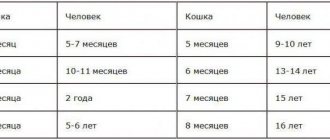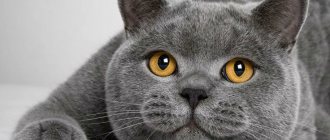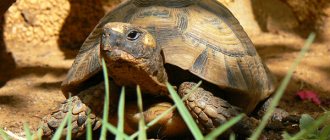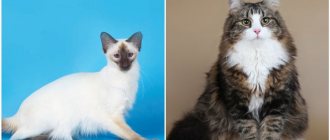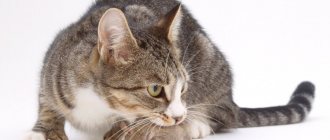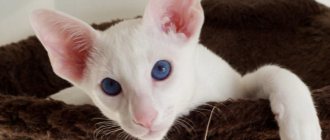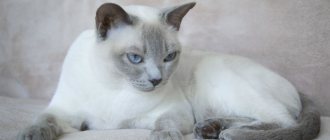If in dogs the breed can be seen at first glance, then some purebred cats are identified only by minor signs. Therefore, a kitten taken from the street can easily turn out to be of “noble blood.” But it makes no sense to determine the breed of a kitten, because with age its color can change radically. Therefore, the question of how to determine the breed of a cat remains open.
How to determine the breed of a cat
The animal is fully formed at one year of age. Then it’s time to figure out how to determine the cat’s breed. It will be difficult for anyone who is not very familiar with cats and does not consider themselves to be professional breeders to determine the breed of the pet. However, this can still be done after analyzing all external signs and his behavior. But is this necessary if the cat is already loyal and loved?
How to find out the cat breed: classification
Phenology clubs are responsible for assigning breeds to cats. Each breed is documented by certificates and meets basic standards.
The first priority in determining the breed is the appearance of the pet. Many factors are assessed, including body build, color, shape of ears and paws. It is the combination of these factors that influences. Thus, Russian Blue and British cats have similar colors, but different exteriors: the former are more refined, with an elongated body, and the latter are strong and massive.
Despite the lists of breeds, it is hardly possible to track their exact number
Now in the world there are about 60 breeds and 200 varieties of cats. It is almost impossible to accurately count their number, even despite the clear gradation by characteristics. The generally accepted classification divides all cats into 5 groups.
Table 1. Classification of cat breeds
| Description | Representatives of the breed | |
| Shorthair | ||
| Slender | Graceful physique; elongated torso | Siamese; Singaporean; Oriental |
| Average | Small body | Burma; Blue Russian |
| Strong | Very large body | European; Burmese; Exotic; American |
| Longhair | ||
| Long coat, wavy or straight; average build | Nibelung, Norwegian Forest, Maine Coon, Ragdoll | |
| With mutations or abnormalities | ||
| Small paws; Crooked ears; Lack of wool. And other possible deformations and discrepancies with breed characteristics | Sphinx, Rex; Bobtail; American Curl | |
If, after lengthy examinations and manipulations, it was not possible to find out the breed, you should contact a veterinarian, professional breeders, or chat with cat lovers on specialized forums. In any case, it is worth knowing exactly the breed of your pet.
A veterinarian can also help determine the breed.
Thoroughbred vs mongrel: distinguish by test questions
Sometimes it is not enough to look at a photo to find out whether a cat is purebred or not. It is necessary to carefully study the pet and find answers to questions that will allow you to think about the true nature of the pet.
So, consider your pet and ask yourself:
- Is the size of the cat smaller or larger than the rest of his furry brothers?
- Does your pet's color look unusual or is it at least somehow different from the color of ordinary cats?
- Are there differences in the hair structure – waves, small curls, too long hair or other features?
- How developed are the limbs, ears, and tail? Are there any noticeable differences?
- Are there any other details in appearance that distinguish your pet from the neighbor's mongrel cat?
Sometimes the pedigree of cats lies “on the surface”, sometimes it does not have clearly defined identifying details
If you answered “yes” to at least 1 question, then your cat is special. To accurately determine its noble breed, it is necessary to delve into the details. So let's get started.
How can you tell if a kitten is purebred or not?
Felinology is a science that studies the characteristics and behavior of domestic cats. This industry employs professionals who can determine the breed of a kitten. All the main features are recorded in the registration books. If your furry friend meets certain standards, he is classified as one or another breed.
A purebred cat is awarded a special document that contains his entire pedigree, the characteristics of the purr breed, and even the names of two or three of his ancestors. Yes, yes, everything is so serious.
Exhibitions: how to get there and why?
Purebred cats and cats of noble breeds receive the right to participate in exhibitions. People gather at these events for various reasons: some people win prestigious titles with their pets, some simply want to communicate with passionate cat lovers, and some want to find a purebred pet for themselves.
WCF Direct Member Certificate
The largest international organization of cat lovers is the World Cat Federation (WCF). It includes 540 clubs from all over the world. WCF holds an average of 300 cat shows annually, a third of which are in Russia.
What does it take to get to a cat show?
Anyone can come to the cat show, but you can only take part with a pet that is already 3 months old. In order for your pet to be included in the list of participants, you need to prepare the following documents:
- a certificate with notes on vaccinations and antiparasitic treatment;
- certificate from a veterinarian in form No. 1 for a period not older than 3 days or in form No. 4.
Important! The exhibition organizers may require additional documents, so for each exhibition the set of papers should be clarified in advance.
How to determine the breed of a cat from a photo?
There is an easier way to determine the breed of a cat. You can simply study photographs of purebred purrs, comparing their appearance with the appearance of your pet. Take a closer look at the size of the fluffies, their color and other external features. In the photo below, I have selected the most common breeds for you so that you can easily figure out whether your cat has a noble origin.
Of course, for true love for animals, it doesn’t matter whether the cat has a breed or not. After all, what could be better than the soothing purring and warmth of your pet. However, I still hope I helped you figure out how to find out the breed of your cat. By the way, if you find out that the furry has noble roots, you can easily return his title by showing your pet to experienced breeders and receiving confirmation.
The 20 most common cats in the world
Every year, the Cat Fanciers' Association (CFA) compiles a ranking of the most popular cat breeds. It is based on the volume of official registrations of purebred cats. So, according to the latest data, more than 2 million individuals are registered with the CFA, belonging to 42 breeds recognized by the corporation.
This time the ranking consists of 20 breeds, which are listed in the table below from last to first place.
Table 2. The most popular purebred cats according to CFA
| Name | Origin | Description |
Exotic cat | The breed was created in the 1960s after crossing a Persian cat with an American Shorthair | Wide stocky body, large paws. The coat is velvety and thick. Cats are calm and affectionate |
Persian cat | The breed originated in Persia, which is now called Iran. In the 17th century it was brought from there to Italy. In 2012-2013, it confidently took 1st place in the ratings, but later lost ground | Dense body, legs short and thick. Round massive head, snub wide nose. The coat is silky and thick |
Maine Coon | The ancestors of modern Maine Coons lived on farms in Northeast America. The name comes from Maine, where they were common. Local farmers associated them with raccoons due to their dark striped color, so they added an additional part of the name - "coon" (literally "raccoon") | A giant cat with large eyes, a fluffy tail and long hair |
Ragdoll | The ancestors of the Ragdoll appeared in California from a mixture of Burmese and Angora cats. The name comes from the peculiarity of this breed: cats completely relax in your arms and allow you to do whatever you want with them. | Large cats with long hair and a bushy tail, round blue eyes |
British shorthair cat | The first purebred Briton was bred in Great Britain in the 19th century | Massive cats with a strong body, small paws and “plush” fur. The eyes are large and protruding |
American shorthair cat | Appeared in North America thanks to the first immigrants from Europe, who brought cats on ships | Strong slender body, hard thick hairs. Round head, eyes wide open. These are independent and active cats. |
Scottish fold cat | The first representative of the fold was discovered in Scotland in 1960. It was a mutated English shorthair cat | The main feature is a gene mutation that results in “broken” cartilage in the ears |
Abyssinian cat | The oldest breed that began its journey from Ethiopia. According to legends, cats of this type were worshiped in Ancient Egypt. Some breeders suspect that the blood of reed wild cats may flow in the veins of Abyssinians | Refined elongated body, thick undercoat, triangular head with deep oval eyes. Unusually colored hairs with ticking |
Canadian Sphynx | Documentary recognition befell the sphinxes in 1966 in Canada. However, some historians claim that representatives of the breed were popular even during the reign of the pharaohs in Egypt and the Mexican Incas | Heavy body of medium size, triangular head. Prominent cheekbones and mustache pads, deep-set eyes |
Oriental shorthair cat | They were brought to Europe along with the Siamese at the end of the 19th century. The ancestors of Oriental cats lived in Thailand. The breed was finally recognized in the 70s simultaneously in the states and in England | An elongated, strong body with a long, sharp tail. Small paws, wedge-shaped head. The color is similar to “Siamese”, but without a clear color-point pattern |
Devon Rex | A cat of this breed was first noticed in Great Britain in 1960. One of the local residents managed to tame a wild pregnant cat, which gave birth to charming wavy kittens | A fragile but muscular body with curly silky hairs, huge ears. Wide head with thin graceful neck |
Siamese cat | Siamese cats first appeared in Siam (modern Thailand). From there they were brought to Europe by the English consul, where they were bred for about 200 years | Flexible, thin body, the front legs are slightly shorter than the hind legs. Characteristic “Siamese” color, bright blue eyes, large ears |
Cornish Rex | The breed was developed in Great Britain in 1950. Later, unusual kittens were crossed with Burmese and British, after which the breed was officially recognized | A small cat with a refined body, a curved back, and large ears. The main feature is long wavy hair |
Norwegian Forest Cat | The breed was bred in Norway. The ancestors of modern Norwegian cats served as assistants on Viking longships | Massive body with long waterproof hairs, triangular head with a flat nose. There are tassels on the wide-set ears, and a voluminous collar on the neck. |
Sacred Burma | The breed was bred in France in the 20s of the last century. In Burma (Myanmar) they were sure that the souls of dead monks lived in these cats, and they were kept in Buddhist monasteries | It has light long hair, pointing colors, characteristic of Siamese cats, and light “socks” on the tips of its paws. There are dark markings on the muzzle, joints and tail. The Burmese has large limbs and a massive body. Their temperament is calm, they are quick-witted and inclined to learn. |
Russian blue | The breed began its development since the times of Old Slavonic times. Outside Rus', they learned about her in 1893, when one of the cat fans took several charming kittens from Arkhangelsk | This is one of the most expensive cats in the world. Has short bluish fur that shimmers with an amazing silvery tint. |
Tonkinese cat | Bred in Vietnam. The breed was the result of crossing Siamese and Burmese cats | Well-developed muscles, slender body, slanting, expressive eyes that change color. High cheekbones and well-shaped muzzle |
Siberian cat | She was born in Siberia in 1988. She is considered the pride of Russian felinology | Medium massive body with thick waterproof coat, strong paws. Large round eyes |
Burmese cat | The first chocolate-colored cat was brought to the states from Rangoon in 1930. There she was crossed with a Siamese cat. From this union came two branches of the Burmese - American (heavier) and British (graceful) | Short silky hair, small body. Cats are muscular and strong. They have large, wide-set eyes |
Ocicat | The first cats of this breed became known in 1964 in the USA, and reached Europe only in the 1990s | They have an animal coloration, but are considered completely domestic. They can be small or large in size, with a lean body and elongated legs. Short, dense coat with spots |
How to properly care for a purebred cat?
Any pet, whether outbred or noble blood, needs decent care. The following procedures will be relevant for all breeds:
Nail trimming and combing
We trim the claws. Nails should be trimmed using a veterinary nail clipper. The most important thing is not to damage the living part of the nail. The vessels on the transparent claw are easily visible. You need to step back 2-3 mm from them and cut off the tip.
Tips for trimming cat's claws
The animal will struggle, so the procedure must be carried out with an assistant. We comb the pet. Cats with luxurious long hair need to be brushed twice a day, and pets with medium-length hair need to be brushed every 3-4 days. The voluminous coat is combed out with a slicker brush and combed with a simple comb.
Hygiene
The list of regular hygiene procedures for cats includes:
- Teeth cleaning. Your pet's teeth should be brushed at least once a week using a cat brush/finger brush and veterinary toothpaste. It is better to instill in your kitten a love for this process from an early age;
- Water procedures. It is not necessary to wash cats often, as water causes them great stress. Bathing is recommended only if the cat is very dirty or before a show. Use special shampoo from a pet store. You can read more about how to wash a cat on our portal.
Some breeds love water and enjoy bath time.
- Eye wash. If discharge appears near your pet's eyes, you need to rinse the eyes with warm water and a cotton swab. If the discharge is cloudy, you need to show the cat to a veterinarian;
- Ear cleaning. The ears should be regularly inspected and wiped with a special solution if dirt appears. Otherwise, serious illnesses may develop.
Wool
Pedigree cats have a wide variety of coats. Long-haired, short-haired, hairless - this is not the entire list of nuances that should be taken into account when caring for the coat of your “aristocrat”. Different breeds have different hair structures, so each of them requires an individual approach. Basic tips for caring for your pet's fur are presented below.
Hair care for purebred cats
Main distinguishing features
Externally, cats have approximately the same appearance. These animals have a rump and chest of medium width, and a rounded head. Representatives of various species acquire certain features of their appearance due to selection work. These include:
- body size;
- the structure of the auricle (unusual shape, deformed cartilage, inversion, etc.);
- limbs (short, regular, elongated);
- wool;
- hair color.
Using these parameters, you can determine whether your pet belongs to a particular species. Let's look at them in more detail.
Body size and structure
An ordinary domestic cat grows up to 75 cm in length. Their tail is about 30 cm long. Standard males weigh 4–6 kg, and females weigh 2.3–4.5 kg. Some breeds weigh much more, their body weight can reach 20 kg.
The largest cat breeds include:
- American Bobtail;
- Kurilian Bobtail;
- Maine Coon;
- British cat;
- Norwegian forest cat;
- ragdoll;
- pixie bob;
- savannah;
- Turkish Van cat;
- Siberian;
- Chartreuse.
There are also small species whose weight does not exceed 2.5 kg. These include bambino, napoleon, dwelf, kinkalow, lambkin, minskin, skiff-tay-don, etc.
Paws
Most cats have limbs of medium length. But many purebred animals have short legs. By this feature, you can easily distinguish representatives of blue blood from ordinary yard animals. Short-footed animals include Napoleons, Minskins, Dwelfs, Skookums, Bambinos and Munchkins. Small paws are compensated by the mobility of the spine. Such a spine will help pets move without difficulty with short limbs.
Tail
Cats usually have a long tail. But some varieties have a short tail, which is a congenital trait and not the result of a surgical procedure. By this sign you can easily recognize purebred animals. However, you need to check whether the short tail is the result of injury. Breeds that have unusual tails include:
- Kymrik is a cat without a tail and with short forelimbs. Because of this, he has a jumping gait;
- Pixie-bob is a miniature lynx. The tail is only 2–15 cm long;
- Manx - tailless animals or with a very long tail;
- American Bobtail – the length of the tail is no more than the base of the hind legs;
- Japanese bobtail – the tail is curled and is about 12 cm long;
- Kurilian bobtail.
Even the rarest breeds can be easily recognized by the structure of the tail.
Ear shape
Outbred pets have a normal ear structure. Aristocrats' ears often have an unusual appearance:
- curved up to 180 degrees back - American curl;
- with deformed cartilage that folds the ear in half - Scottish fold cat;
- rolled up - in representatives of the Ukrainian Levka variety;
- patterned and large sizes - elf cat.
Other aristocratic breeds will have ears similar to one of the types described above.
